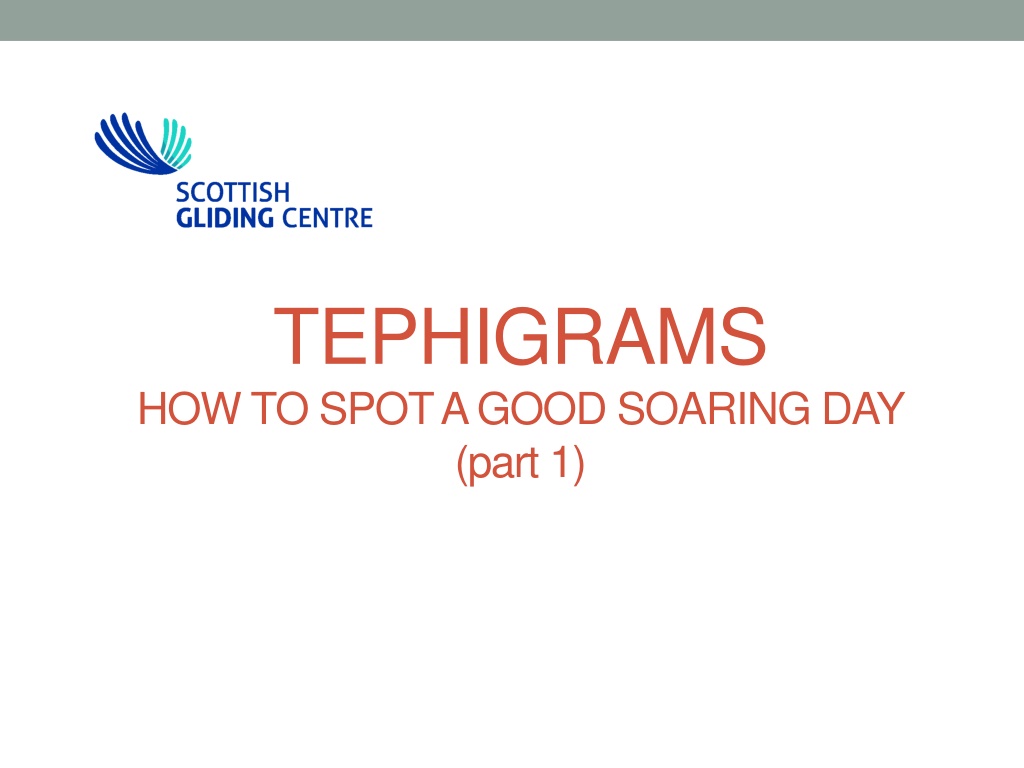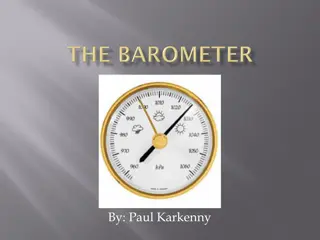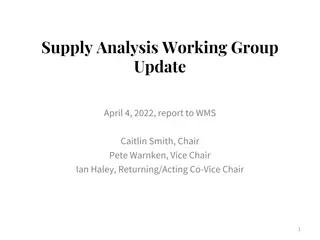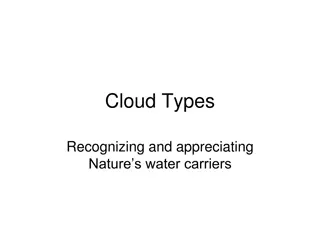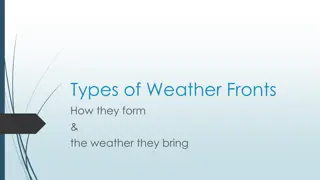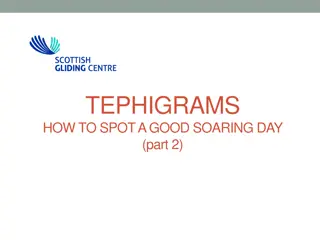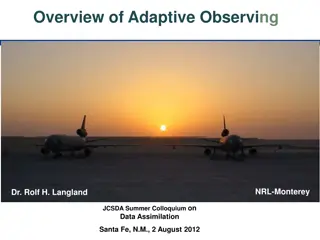Understanding Tephigrams for Soaring Weather Forecasting
Tephigrams are essential tools for glider pilots to analyze atmospheric conditions for soaring flights. They display data on air temperature, dew point, and wind velocity, helping in assessing thermal activity and potential wave days. By examining tephigrams, pilots can determine the presence of cloud layers, freezing levels, and wind velocities at various altitudes. The data is sourced from radiosonde measurements or weather forecasting models like SkySight and RASP. Learn how to read and interpret tephigrams for picking optimal soaring days.
Download Presentation

Please find below an Image/Link to download the presentation.
The content on the website is provided AS IS for your information and personal use only. It may not be sold, licensed, or shared on other websites without obtaining consent from the author. Download presentation by click this link. If you encounter any issues during the download, it is possible that the publisher has removed the file from their server.
E N D
Presentation Transcript
TEPHIGRAMS HOW TO SPOT A GOOD SOARING DAY (part 1)
Tephigrams What are they? What useful stuff do they show? How can I use them to pick a good day?
Tephigrams..or??? Tephigram => Tee phi gram, teffygram or Log P Skew T plot or Skew T plot or Sounding
Tephigrams where can I find them? Synthetic tephigrams 1. RASP link is in the Pilot s section of the SGC website They are called soundings on RASP. Easy to see and use. Can generate you own set of soundings for any BGA turnpoint 2. SkySight Less user friendly even though it has an interactive tool. Again can generate a Skew-T plot for any place at any time Real soundings 1. http://weather.uwyo.edu/upperair/sounding.html 2. meteocentre.com
Tephigrams what do they do? Two separate functions 1. Display air temperature and dew-point data versus height above a given location at a given time wind velocity with height is shown as well always check the location, time and date 2. Permit quick, basic assessment of thermal activity via calculating curves also useful for spotting potential wave days
Tephigram from RASP Wind info Air temp Dewpoint temp Height Temp
Tephigrams the data comes from? Air temperature, dew-point, and wind velocity data from; direct measurements using a radiosonde on a balloon ( sounding ), or more frequently output from computational weather forecasting models SkySight, RASP, etc. and we can access this in the form of a tephigram.
Tephigrams simple observations Looking at several forecast tephigrams for the day 1. Are there cloud layers present (dew-point equal to air temperature)? 2. How close are the air temperature and dew-point lines? Is it likely to become cloudy? Lines closer than 2C? 3. Where is the freezing level? Brrr /Showers/icing in cloud?? 4. What is the wind velocity on the ground and at soaring height?
Tephigrams low cloud layer Cloudiness indicator Cloud top & base
Tephigrams freezing level? Air temp Freezing level at +12,000 0 deg isotherm
Tephigrams ANY QUESTIONS SO FAR?
Tephigrams At a basic level, what does a good soaring day look like on a tephigram?
Tephigrams Dry Adiabatic Lapse Rate Curves these apply in clear air
Tephigrams Saturated Adiabatic Lapse Rate Curves these apply in clouds
Tephigram from RASP Wind info Air temp Dewpoint temp Height Temp
Tephigrams stability, whats that? Atmospheric stability is a very important factor in the formation of thermals and wave as they depend upon the right degree of stability (or instability) In the atmosphere, stability means that if a parcel of air is displaced up or down from an initial height, the parcel will tend to return to that initial height. What makes a parcel of air return to the level it came from? As a parcel of air rises it expands and cools. This cooling is caused by the expansion and is not due to the surrounding air If the temperature of the parcel drops so that it is the same or less than the surrounding air it will stop rising and start to descend as it will be more dense than the surrounding air And vice versa for air descending from its initial height For this to happen the change in the parcel temperature with height must be more than thechange in the surrounding air temperature with height
Tephigrams - stability Stable layer
Tephigrams - a good thermal day Lower air temperature profile follows dry (clear air) curves from the ground up (well mixed layer) 1. A stable layer / inversion at a reasonable height (top of thermal) 2. Cloudbase present at a reasonable height (not blue thermals) 3. Dry air above cloud level to minimise cumulus spread-out 4. Low wind speed (<15kts) within thermalling layer 5. No or thin upper cloud cover 6.
Tephigram a good thermal day Wind info Air temp Dewpoint temp 4.Dry air Height 2.Inversion 3. Cumulus cloud? 5. Low windspeed 1.Well-mixed layer Temp
Tephigrams - a good wave day 1. Wind speed > 10-15kts at hill tops (~3-4000 ) and gradually increasing with height Not too windy at cruising level (<50kts) 2. Wind direction relatively constant with height and from SW to N (at Portmoak) 3. Inversion or isothermal layer present at height of hill tops/ridges 4. Stable, relatively dry air above and below the inversion too dry blue wave too moist cloud filled (and possibly convective/conditionally unstable)
Tephigrams a good wave day 6.Stable layer 1&2. Wind Profile 5.Dry air 3.Inversion 4.Stable layer
Further reading / resources SSA note on T-Phi grams is excellent SkySight has a link to this page Skew T Reading 2 JDM .docx (flsc.org) RASP has a tutorial as well Or just Google gliding tephigrams and some good stuff will pop-up such as; Tephigrams for Dummies - flynorfolk.org (this is quite good) Bicesters Gliding Blog: The Rasp skew T explained (bicester- gliding.blogspot.com) YouTube - Thermobytes a series of 91 short (3-10min) videos from Australian Bureau of Meteorology covering many components of T-phi plots. Blank Tephigram charts at Bret's Skew-T/ln p Graph (bretwhissel.net)
